| Workable Solutions | Step-by-step Troubleshooting |
|---|---|
| Fix 1. Connect an External Mouse to Your MacBook Pro | Turn on your wireless mouse, and install its batteries. Open the "System Preferences" ...Full steps |
| Fix 2. Disable Force Click to Fix MacBook Pro Trackpad Not Working | Go to the Apple menu and select "System Preferences". Select "Trackpad" from the list of options...Full steps |
| Fix 3. Fix MacBook Pro Trackpad Not Clicking in System Preferences | Click on the apple icon on the top left and select "System Preferences". Select "Accessibility" from...Full steps |
| Fix 4. How to Reset MacBook Pro Trackpad Settings | Select "System Preferences" from the dropdown menu by clicking on the apple icon on the left...Full steps |
| Other Solutions | Shut down your MacBook pro. Hold down the "Shift" + "Control" + "Option" keys...Full steps |
MacBook Pro Trackpad Not Working Overview
Do you need more clarification about MacBook pro trackpad not working? Let us help you! The MacBook Pro trackpad is a built-in input device that lets users control their MacBook without requiring an external mouse. The MacBook Pro trackpad is a flat surface beneath the keyboard and provides a variety of touch-based input methods. This MacBook Pro trackpad not working issue can be caused by various reasons, including software updates, settings issues, and hardware malfunctions. It can lead to frustration and directly impact their ability to work efficiently.
For example, if you use a MacBook for personal use, a non-clicking trackpad can be frustrating and hinders you from enjoying your device's full range of features and functions. In addition, if you have recently updated your MacBook's operating system or installed new software, this can sometimes lead to trackpad issues or cause the MacBook Pro touch bar not working. Finally, if you have dropped or damaged your MacBook, this can result in physical damage to the trackpad that requires repair or replacement in certain cases.
Fix 1. Connect an External Mouse to Your MacBook Pro
Are you looking at how to use an external mouse on Mac? You have come to the right place! It is a simple process and can be performed with the easy-to-follow steps mentioned below:
Step 1. Turn on your wireless mouse, and install its batteries.
Step 2. Open the "System Preferences" menu from the Apple menu on the top.
Step 3. Select "Bluetooth" from the options available.
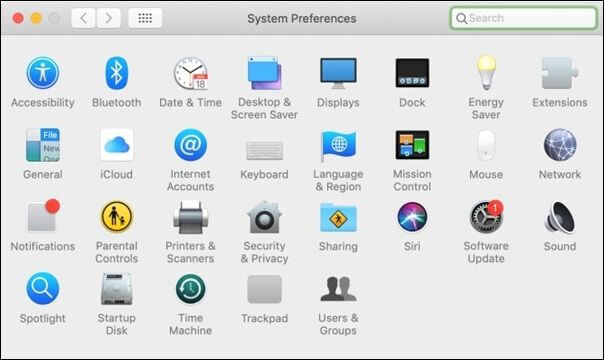
Step 4. Click "Pair" on your wireless mouse to make it discoverable, and wait for your Mac to detect and connect to the mouse automatically.

Fix 2. Disable Force Click to Fix MacBook Pro Trackpad Not Working
Looking for another solution to resolve this issue? This section is for you! One possible solution is disabling the Force click. As it is clear from its name, force click is a MacBook feature that allows you to access additional functionalities by clicking the trackpad with some extra force. However, if this feature is not working correctly, it can cause issues with the trackpad's clicking function. Therefore, disabling this feature with the simple steps below is better.
Step 1. Go to the Apple menu and select "System Preferences".
Step 2. Select "Trackpad" from the list of options.

Step 3. Uncheck the box next to "Force Click and haptic feedback".
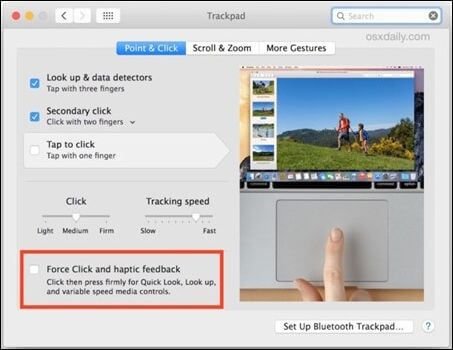
Fix 3. Fix MacBook Pro Trackpad Not Clicking in System Preferences
Does your MacBook's trackpad need to be fixed? Do not panic! If your MacBook Pro trackpad is still not clicking after trying the above solutions, you may need to adjust some settings in System Preferences to fix the issue. Here are the steps to follow.
Step 1. Click on the apple icon on the top left and select "System Preferences".
Step 2. Select "Accessibility" from the list of options.

Step 3. Click "Mouse & Trackpad" in the left-hand menu.
Step 4. Ensure the box next to "Ignore built-in trackpad when mouse or wireless trackpad is present" is unchecked.

Fix 4. How to Reset MacBook Pro Trackpad Settings
Are you looking to reset the trackpad setting on your Macbook? Let us help you with that! Resetting the settings can be a convenient solution because sometimes, the change in settings disrupts the functionality of the trackpad, and it is considered good practice to switch the settings and options back to normality. You can get back to the original settings by following the below-mentioned steps.
Step 1. Select "System Preferences" from the dropdown menu by clicking on the apple icon on the left.
Step 2. Now, scroll down and click on "Trackpad".
Step 3. Select "Point & Click" and un-check the "Tap to Click" and "Scroll down" options.

Fix 5. Reset SMC to Fix MacBook Pro Trackpad Not Working
Are you still trying to figure out how to fix your MacBook's trackpad not working? You have come to the right section! SMC stands for System Management Controller, a chip in your Mac responsible for controlling various hardware functions such as power management, battery management, thermal management, and more. Resetting the SMC can often fix issues with hardware-related problems on a MacBook Pro, including the trackpad not clicking. Here are the easy and quick steps to follow and complete MacBook Pro resetting SMC.
Step 1. Shut down your MacBook pro.
Step 2. Hold down the "Shift" + "Control" + "Option" keys on the left-hand side of the keyboard and the "Power" button simultaneously for 10 seconds.
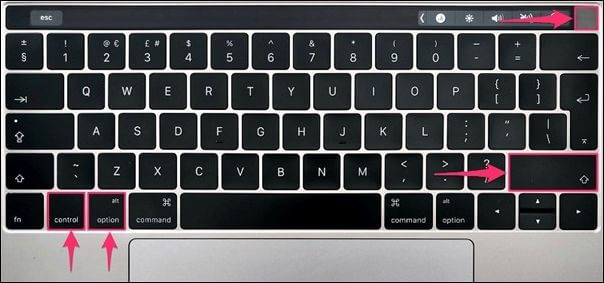
Step 3. Release all the keys and turn on your MacBook Pro.
Step 4. Check your trackpad; the issue might be resolved.
Fix 6. How to Reset NVRAM or PRAM on MacBook Pro
Are you looking out how to fix your MacBook's trackpad not working? This section is for you! NVRAM (Non-Volatile Random-Access Memory) and PRAM (Parameter RAM) are types of memory in a MacBook that store certain settings related to system configuration and hardware preferences. Resetting the NVRAM (Non-Volatile Random-Access Memory) or PRAM reset Mac (Parameter RAM) can help fix the trackpad not clicking issue. Here are the quick steps to follow.
Step 1. Turn off your MacBook Pro by clicking on the "Apple icon"> "Shut Down...".
Step 2. Press the power button to turn it on, then immediately press and hold the "Command" + "Option" + "P" + "R" keys on your keyboard.
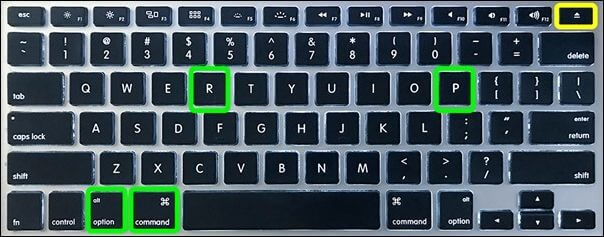
Step 3. Hold these keys until you hear the startup sound twice. This usually takes around 20 seconds.
Step 4. Release the keys and wait for your MacBook Pro to start.
Fix 7. Run Apple Diagnostics to Troubleshoot MacBook Pro
Are you looking to use the Apple diagnostic to fix your MacBook's trackpad not working? You have come to the right place! Use Apple Diagnostics to test your Mac's hardware components, including the logic board, memory, and storage, to check for any issues. Running apple diagnostic will provide you with the description of the problem if found. Below-mentioned is the quick steps to follow.
Step 1. Connect your MacBook to the power adapter and shut it down.
Step 2. Press the power button to turn it on and immediately hold your keyboard's "D" key.
Step 3. Wait for the Apple Diagnostics screen to appear and follow the on-screen instructions to run the diagnostic test.

Step 4: Once the test is complete, review the report for any hardware issues related to the trackpad not clicking.
Fix 8. Delete Some Plist Files to Fix MacBook Pro Trackpad
Are you worried because none of the methods have worked so far for you? This one surely will! The Property list (plist) files store preferences and configuration information for various applications and processes on a Mac. They are used by macOS to store various settings and preferences, such as keyboard shortcuts, display resolution, network configurations, and more. Deleting a plist file associated with a trackpad can often help to resolve this issue by following the quick steps below:
Step 1. Open Finder on your MacBook Pro and select "Go to Folder" from the "Go" menu.
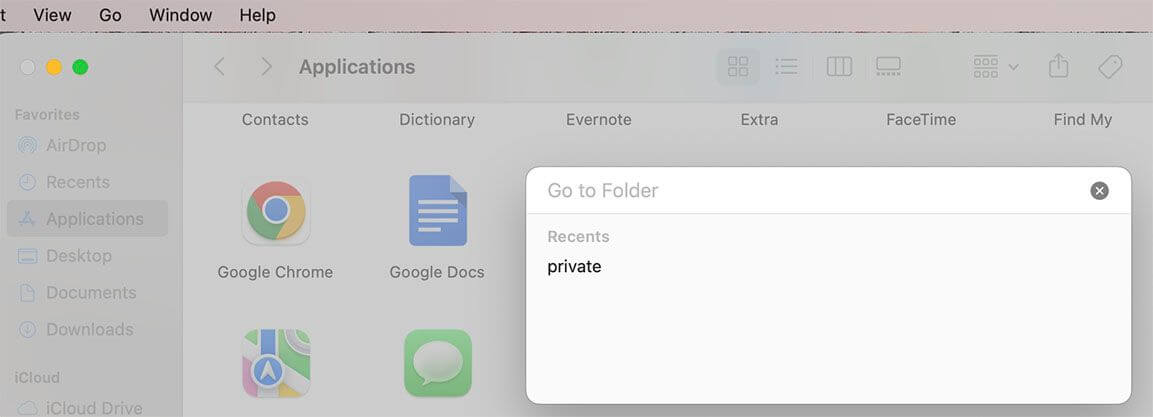
Step 2. Type "/Library/Preferences" in the "Go to Folder" dialog box and hit "Go."
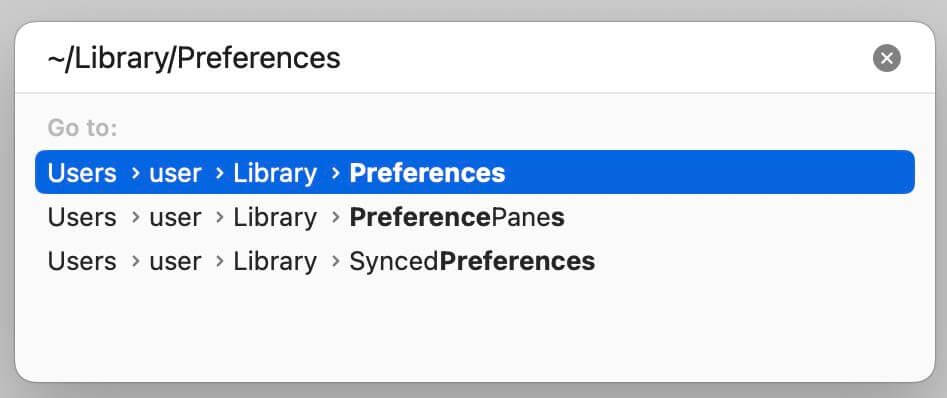
Step 3. Look for plist files containing "trackpad" in the file name or description.
Step 4. Drag these files to the Trash and restart your MacBook Pro. Test the trackpad to see if it is clicking again.
Fix 9. Update or Reinstall macOS on MacBook Pro
Are you still bewildered and looking for a permanent fix? This one will help you! In this method, you have to update the macOS. If that does not work, you can reinstall it from Mac Recovery Mode. It is essential to back up your data before updating or reinstalling macOS on your MacBook Pro. You can transfer your files to an external hard drive or cloud storage service like iCloud or Dropbox. To update or reinstall macOS to fix the trackpad not clicking issue, follow these steps:
Step 1. Click on the Apple menu and select "System Preferences."
Step 2. Click "Software Update" and check for available updates. If open, click "Update Now" to install it on Mac.
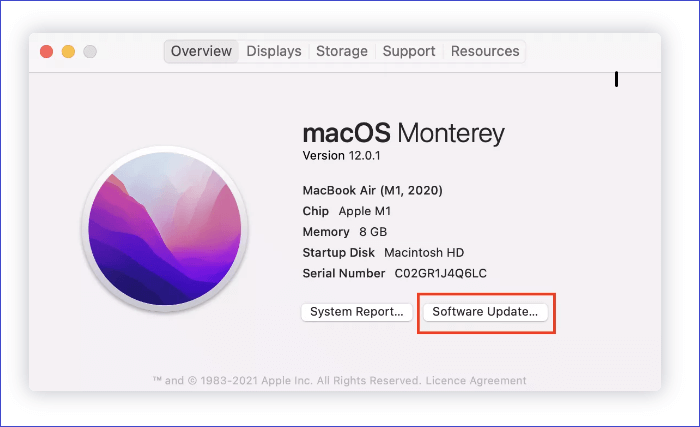
Step 3. Another option is reinstalling the macOS by holding the "Command" + "R" keys until you see an apple logo. This will boot your MacBook into macOS Recovery.
Step 4. Select "Reinstall macOS Ventura" and follow the easy on-screen instructions.
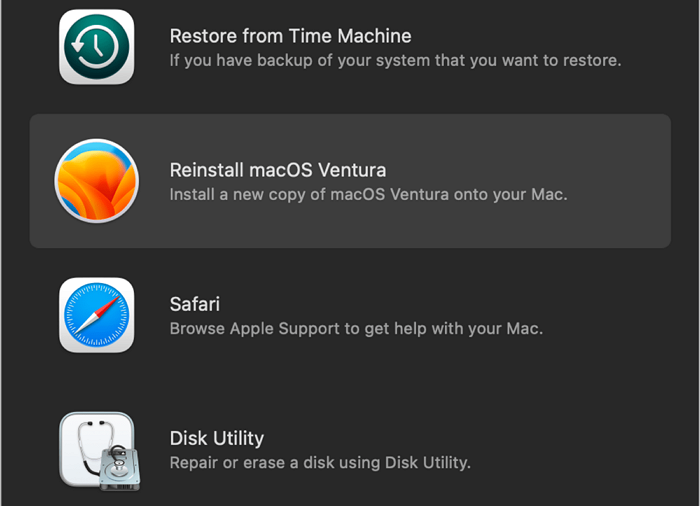
Fix 10. Reset MacBook Pro to Factory Settings
Do you look forward to factory reset Macbook Pro to fix this issue? You have come to the right section! Resetting your MacBook Pro to factory settings can help fix the trackpad not clicking issue. However, this process erases all data and settings on your MacBook Pro, so it is important to back up your data before proceeding. To reset your MacBook Pro to its factory settings, follow these steps:
Step 1. Click on the Apple menu and select "Restart," and simultaneously hold down "Command" + "R" until the Apple logo appears to boot your MacBook Pro into macOS Recovery.
Step 2. Select "Disk Utility" in macOS Recovery and click "Continue."
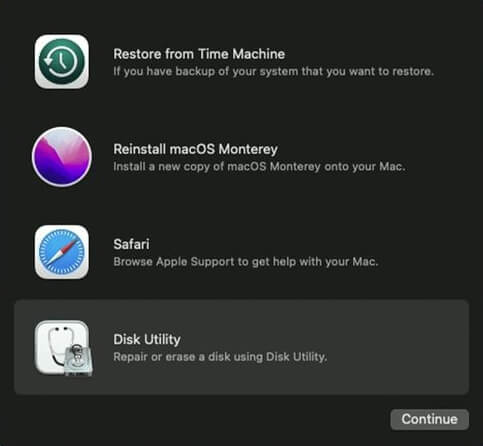
Step 3. Select your startup disk and click "Erase" to erase your hard drive.
Step 4. After erasing your hard drive, click "Reinstall macOS" to reinstall the operating system and follow the on-screen instructions.
Recover Lost Data When Fixing MacBook Pro Trackpad Not Working
When trying to fix the MacBook Pro trackpad not working issue, you may lose some of your important data. One method where you can potentially lose data is when you reset your MacBook Pro to factory settings. This process erases all the data from your device, so it is important to back up your data beforehand. In such cases, you can use a reliable data recovery tool like EaseUS Data Recovery Wizard for Mac to recover lost data.
- This is a powerful and reliable tool for data recovery. It is handy for new users and you can use it even if your MacBook Pro trackpad is not working.
- This software is designed to recover deleted files Mac, including documents, photos, videos, audio files, and more. Its advanced scanning algorithms can search for lost files in deep storage sectors, providing a high recovery rate.
- This program can help you recover data whether you lose data due to accidental deletion, system crash, or formatting. Even work after you erase all content and settings on your Mac.
To get benefit from this handy tool, you can follow the easy instructions given below:
Step 1. Search for lost files
Select the disk location to search for lost files (it can be an internal HDD/SSD or a removable storage device) on macOS Sierra, High Sierra, Mojave, Catalina, Big Sur, Monterey, Ventura, and the latest Sonoma. Click the "Search for lost files" button.
Note: Before data recovery, you'd better click "Disk Backup" from the left sidebar to create a backup of your Mac to avoid further data loss. After backing up, the software can recover data from the Mac backup, and your computer can wirte new data again.

Step 2. Go through the scanning results
EaseUS Data Recovery Wizard for Mac will immediately scan your selected disk volume and display the scanning results.

Step 3. Select the file(s) and recover
In the scan results, select the file(s) to preview and click the "Recover" button to have them back.

Bottom Line
In summary, the MacBook Pro trackpad not working can be a frustrating issue for users. However, several fixes are available that users can try to resolve the problem, ranging from disabling Force Click to resetting NVRAM or PRAM, updating or reinstalling macOS, and resetting the MacBook Pro to factory settings. While attempting these solutions, it is important to remember that data loss is possible. Users may need a powerful and reliable data recovery tool like EaseUS Data Recovery Wizard for Mac to recover any lost files. Hence, it is highly recommended to download it for safe and effective data recovery.
1
MacBook Pro Trackpad Not Working FAQs
Do you still have some doubts in mind? This part will help you!
1. Why is the MacBook Pro trackpad not clicking?
The MacBook Pro trackpad may not be clicking for various reasons, such as outdated software, disabled settings, or corrupted files. It could also be a result of hardware issues or physical damage. Users can troubleshoot the issue by following the suggested solutions and getting their trackpad clicking again.
2. How do I fix MacBook Pro shift key not working?
To resolve the issue of the shift key not working on Mac, you can try resetting the SMC or PRAM. You may need to clean the keyboard or replace it if that does not work. It is also recommended to check for software updates or run diagnostics to rule out any underlying issues.
3. How to make my MacBook Pro Trackpad click?
If your MacBook Pro trackpad is not clicking, there are several things you can do to fix it. You need to check first if the trackpad is dirty or damaged. If so, clean it carefully and make sure there is no debris. You can also try restarting your Mac or adjusting the trackpad settings in System Preferences. If none of these tips and tricks work, you may need to reset your NVRAM, PRAM, or SMC or reinstall the macOS.
4. Why does my MacBook Pro trackpad not click sound?
There could be several reasons why your MacBook Pro trackpad is not making a clicking sound. It could be due to a hardware issue, such as a faulty trackpad, or a software issue, such as incorrect settings or outdated drivers. Additionally, if you have accidentally spilled liquid on your MacBook Pro, this could also affect the trackpad's functionality.
Was This Page Helpful?
Daisy is the Senior editor of the writing team for EaseUS. She has been working at EaseUS for over ten years, starting as a technical writer and moving on to being a team leader of the content group. As a professional author for over ten years, she writes a lot to help people overcome their tech troubles.
Dany is an editor of EaseUS who lives and works in Chengdu, China. She focuses on writing articles about data recovery on Mac devices and PCs. She is devoted to improving her writing skills and enriching her professional knowledge. Dany also enjoys reading detective novels in her spare time.
Related Articles
-
5 Best Ways to Fix Gmail Won't Attach Files Error
![author icon]() Daisy/2024-01-11
Daisy/2024-01-11 -
How Long Does It Take to Format an External Hard Drive [Full Guide]
![author icon]() Sherly/2024-07-01
Sherly/2024-07-01 -
How to Fix 'the Archive Is Either in Unknown Format Or Damaged' [100% Working Solution]
![author icon]() Cici/2024-07-01
Cici/2024-07-01 -
Top 2 Ways | How to Create Bootable USB from ISO Windows 10
![author icon]() Jerry/2024-06-06
Jerry/2024-06-06
EaseUS Data Recovery Services
EaseUS data recovery experts have uneaqualed expertise to repair disks/systems and salvage data from all devices like RAID, HDD, SSD, USB, etc.
